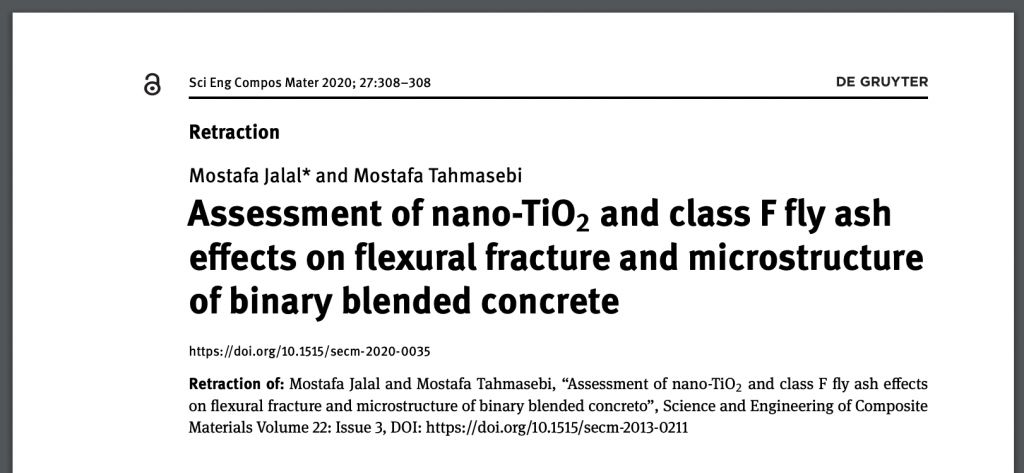
An engineering researcher alleged to be part of a four-group ring of authors who have “repetitively published their own work in ways that call into serious question” the validity of hundreds of papers has had a paper retracted.
As we reported in August, Mostafa Jalal, a postdoc at Texas A&M, is alleged to have “engaged in some manner of collaboration or communication” with three other researchers, including Ali Nazari, who has now had 52 papers retracted. Those retractions came after the whistleblower, the pseudonymous Artemisia Stricta, called attention to problems in Nazari’s work.
The newly retracted paper, originally published in 2013 in Science and Engineering of Composite Materials, is one of five publications in which Artemisia Stricta said Jalal’s group had misrepresented electron microscopy images.
Here’s the retraction notice for “Assessment of nano-TiO2 and class F fly ash effects on flexural fracture and microstructure of binary blended concrete”:
This article has been retracted at the request of the Editor-in Chief, as it contains large portions of text that have been duplicated from the article: “Effects of fly ash and TiO2 nanoparticles on rheological, mechanical, microstructural and thermal properties of high strength self compacting concrete”, co-authored by Mostafa Jalal, Mojtaba Fathi, and Mohammad Farzad, in the journal of Mechanics of Materials, 61, 2013, 11-27, DOI: https://doi.org/10.1016/j.mechmat.2013.01.010
Artemisia Stricta explains in his report that the paper from which the text is duplicated is “nearly identical” to a 2010 paper by Nazari’s group:
In certain cases, the connection between the groups’ publications is undeniable. In 2010, the Nazari group published a paper titled, “The effect of TiO2 nanoparticles on water permeability and thermal and mechanical properties of high strength self-compacting concrete”. In 2013, the Jalal group published a paper titled, “Effects of fly ash and TiO2 nanoparticles on rheological, mechanical, microstructural and thermal properties of high strength self compacting concrete”. The reported work was nearly identical.
Figure 6 contrasts a few of the similarities between the papers. Both groups reportedly tested the effects of nano-TiO2 on high-strength self-compacting concrete. Both groups reported similar mix designs and a nano-TiO2 content of 0% (control), 1%, 2%, 3%, 4%, and 5%. Both teams performed compressive tests, tensile tests (flexural or splitting), water permeability tests, mercury intrusion porosimetry, conduction calorimetry, thermogravimetric analysis, scanning electron microscopy, and X-ray diffraction. The methods and results were reported in extremely similar terms, in the same order, and with uncannily similar formatting and word choice between the two papers. For the benefit of people unfamiliar with the field, I will say that none of these approaches or methods are necessarily unusual. However, such an extensive similarity across two research groups is unlikely to be coincidental.
Jalal has not responded to a request for comment about this retraction, but he provided this three-page response in August to Artemisia Stricta’s allegations. At the time, he denied any collaboration with Nazari.
Like Retraction Watch? You can make a tax-deductible contribution to support our work, follow us on Twitter, like us on Facebook, add us to your RSS reader, or subscribe to our daily digest. If you find a retraction that’s not in our database, you can let us know here. For comments or feedback, email us at [email protected].
Excuse me, but how do you know Artemisia Stricta is a man? The pseudonym presents as female, but the nature of pseudonyms is that we don’t know. Would you consider a correction?